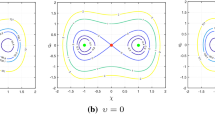Abstract
In this study, the relationship between the limit of predictability and initial error was investigated using two simple chaotic systems: the Lorenz model, which possesses a single characteristic time scale, and the coupled Lorenz model, which possesses two different characteristic time scales. The limit of predictability is defined here as the time at which the error reaches 95% of its saturation level; nonlinear behaviors of the error growth are therefore involved in the definition of the limit of predictability. Our results show that the logarithmic function performs well in describing the relationship between the limit of predictability and initial error in both models, although the coefficients in the logarithmic function were not constant across the examined range of initial errors.
Compared with the Lorenz model, in the coupled Lorenz model—in which the slow dynamics and the fast dynamics interact with each other—there is a more complex relationship between the limit of predictability and initial error. The limit of predictability of the Lorenz model is unbounded as the initial error becomes infinitesimally small; therefore, the limit of predictability of the Lorenz model may be extended by reducing the amplitude of the initial error. In contrast, if there exists a fixed initial error in the fast dynamics of the coupled Lorenz model, the slow dynamics has an intrinsic finite limit of predictability that cannot be extended by reducing the amplitude of the initial error in the slow dynamics, and vice versa. The findings reported here reveal the possible existence of an intrinsic finite limit of predictability in a coupled system that possesses many scales of time or motion.
Similar content being viewed by others
References
Benettin, G., L. Galgani, A. Giorgilli, and J. M. Strelcyn, 1980: Lyapunov characteristics exponents for smooth dynamical systems and for Hamiltonian systems; a method for computing all of them. Meccanica, 15, 9–20.
Boffetta, G., P. Giuliani, G. Paladin, and A. Vulpiani, 1998: An extension of the Lyapunov analysis for the predictability problem. J. Atmos. Sci., 55, 3409–3416.
Chen, W. Y., 1989: Estimate of dynamical predictability from NMC DERF experiments. Mon. Wea. Rev., 117, 1227–1236.
Chou, J. F., 1989: Predictability of the atmosphere. Adv. Atmos. Sci., 6, 335–346.
Dalcher, A., and E. Kalnay, 1987: Error growth and predictability in operational ECMWF forecasts. Tellus A, 39, 474–491.
Ding, R. Q., and J. P. Li, 2007: Nonlinear finite-time Lyapunov exponent and predictability. Physics Letters A, 364, 396–400.
Ding, R. Q., G. L. Feng, S. D. Liu, S. K. Liu, S. X. Huang, and Z. T. Fu, 2006: Review of the study of nonlinear atmospheric dynamics in China (2003–2006). Adv. Atmos. Sci., 24, 1077–1085, doi: 10.1007/s00376-007-1077-7.
Eckmann, J. P., and D. Ruelle, 1985: Ergodic theory of chaos and strange attractors. Reviews of Modern Physics, 57, 617–656.
Krishnamurthy, V., 1993: A predictability study of Lorenz’s 28-variable model as a dynamical system. J. Atmos. Sci., 50, 2215–2229.
Leith, C. E., 1971: Atmospheric predictability and twodimensional turbulence. J. Atmos. Sci., 28, 145–161.
Leith, C. E., and R. H. Kraichnan, 1972: Predictability of turbulent flows. J. Atmos. Sci., 29, 1041–1052.
Li, J. P., and R. Q. Ding, 2011a: Temporal-spatial distribution of atmospheric predictability limit by local dynamical analogues. Mon. Wea. Rev., 139, 3265–3283.
Li, J. P., and R. Q. Ding, 2011b: Relationship between the predictability limit and initial error in chaotic systems. Chaotic Systems, Esteban Tlelo-Cuautle, Ed., InTech Press, 39–50.
Lorenz, E. N., 1963: Deterministic nonperiodic flow. J. Atmos. Sci., 20, 130–141.
Lorenz, E. N., 1965: A study of the predictability of a 28-variable atmospheric model. Tellus, 3, 321–333.
Lorenz, E. N., 1969a: The predictability of a flow which possesses many scales of motion. Tellus, 21, 289–307.
Lorenz, E. N., 1969b: Atmospheric predictability as revealed by naturally occurring analogues. J. Atmos. Sci., 26, 636–646.
Lorenz, E. N., 1982: Atmospheric predictability experiments with a large numerical model. Tellus, 34, 505–513.
Lorenz, E. N., 1996: Predictability: A problem partly solved. Proc. ECMWF Seminar on Predictability, Vol. I, Reading, United Kingdom, ECMWF, 1–18.
Metais, O., and M. Lesieur, 1986: Statistical predictability of decaying turbulence. J. Atmos. Sci., 43, 857–870.
Mu, M., W. S. Duan, and J. C. Wang, 2002: The predictability problems in numerical weather and climate prediction. Adv. Atmos. Sci., 19, 191–204.
Nohara, D., and H. L. Tanaka, 2001: Logarithmic relation between the initial error and predictability for the barotropic component of the atmosphere. J. Meteor. Soc. Japan, 79, 161–171.
Oseledec, V. I., 1968: A multiplicative ergodic theorem: Lyapunov characteristic numbers for dynamical systems. Trans. Moscow Math. Soc., 19, 197–231.
Palmer, T. N., 2006: Predictability of weather and climate: From theory to practice. Predictability of Weather and Climate, T. Palmer and R. Hagedorn, Eds., Cambridge University Press, 1–10.
Shimada, I., and T. Nagashima, 1979: A numerical approach to ergodic problem of dissipative dynamical systems. Progress of Theoretical Physics, 61, 1605–1616.
Simmons, A. J., R. Mureau, and T. Petroliagis, 1995: Error growth and estimates of predictability from the ECMWF forecasting system. Quart. J. Roy. Meteor. Soc., 121, 1739–1771.
Store, R., and J. F. Royer, 1993: Comparison of different error growth formulas and predictability estimation in numerical extended-range forecasts. Ann. Geophys., 11, 296–316.
Toth, Z., 1991: Estimation of atmospheric predictability by circulation analogs. Mon. Wea. Rev., 119, 65–72.
van den Dool, H. M., 1994: Searching for analogues, how long must we wait? Tellus, 46A, 314–324.
Wolf, A., J. B. Swift, H. L. Swinney, and J. A. Vastano, 1985: Determining Lyapunov exponents from a time series. Physica D, 16, 285–317.
Zhou, X. J., 2005: Atmospheric stochastic dynamics and predictability. Acta Meteorologica Sinica, 63, 806–811. (in Chinese)
Author information
Authors and Affiliations
Corresponding author
Rights and permissions
About this article
Cite this article
Ding, R., Li, J. Relationships between the limit of predictability and initial error in the uncoupled and coupled lorenz models. Adv. Atmos. Sci. 29, 1078–1088 (2012). https://doi.org/10.1007/s00376-012-1207-8
Received:
Revised:
Published:
Issue Date:
DOI: https://doi.org/10.1007/s00376-012-1207-8



